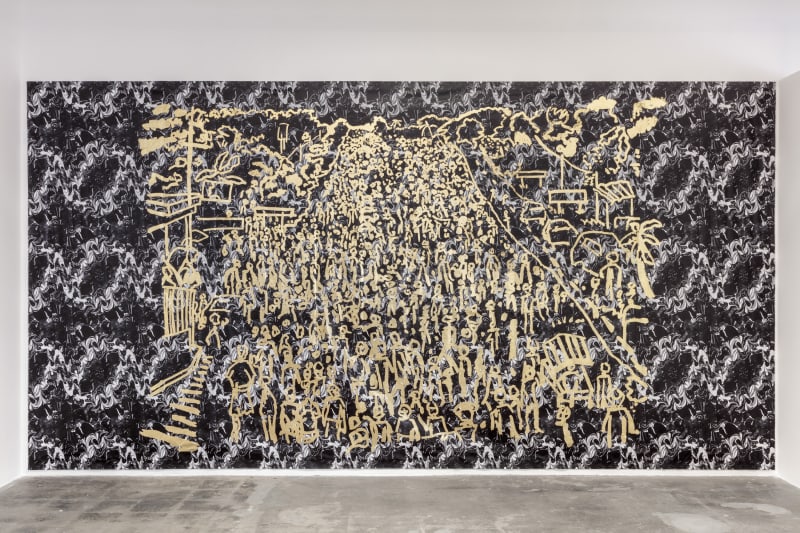Review of the exhibition Golden Anesthesia, Baer Gallery, 2019.
Baroque is back, at least in the eyes of Italian artist Francesca Longhini, whose paintings are on view at Baert Gallery. Although they eschew the tortured perspectives and theatrical lighting of Italian Baroque, they proffer their own version of the style’s drama and excess. They are dazzling in their too-muchness.
“Migrant Caravan,” which is nearly 10 feet high and 19 feet across, depicts a mass of people streaming up a mountain road. The fabric background is printed in a black and white marbled pattern of Longhini’s devising, and the figures and scenery are all “painted” in gold leaf. Longhini paints with glue, which quickly becomes invisible against the variegated ground. She then applies the gold foil. The resulting image is a paradox, a loose but gilded sketch blown up to mural size.
The other large painting in the show, “Disco!” is executed in the same manner, but depicts a very different subject: a crowded dance floor, beneath a sweeping balcony full of spectators. The disjuncture is puzzling. While “Migrant Caravan” could be read as a commentary on our twisted political times, “Disco!” feels celebratory, even ebullient.
Both images focus on crowds, layered atop busy backgrounds. The overall effect is something like static: You hardly know where to look. Also, the gold leaf catches the light, making the figures flicker in and out of recognition. Longhini’s interest in these images seems formal rather than topical, borne out by the rest of the paintings in the show, which are diminutive and restrained by comparison.
Although they also contain gold leaf, these delicate abstract works predate their larger cousins. Where the large works are bombastic and disorienting, the small paintings are intimate and slyly humorous. Composed of tiny, carefully plotted squares, lines and rectangles, they are little disquisitions on tension and balance, suggesting an animate abstract world.
“To Argue With an Uncompleted Ellipse,” from 2017 is an unclosed loop of green, gray and gold squares, whose open end is guarded by two long rectangles. One of these is clearly pointed in the wrong direction. The ellipse, heretofore so carefully constructed, appears doomed. Best-laid plans go awry with just one wrong turn.
These paintings are about the mechanics of making an image, but they also allude to the mechanics of real life. Perhaps that’s the best way to understand the caravan/disco disconnect. They’re two very different kinds of crowds, assembled for very different reasons, but Longhini’s strategy of “baroque” excess renders them similar, erasing the very great distances between them. This is irresponsible, but also gestures toward the way we consume images. Flowing endlessly across our screens everyday, they become their own trail of dazzling sameness.

